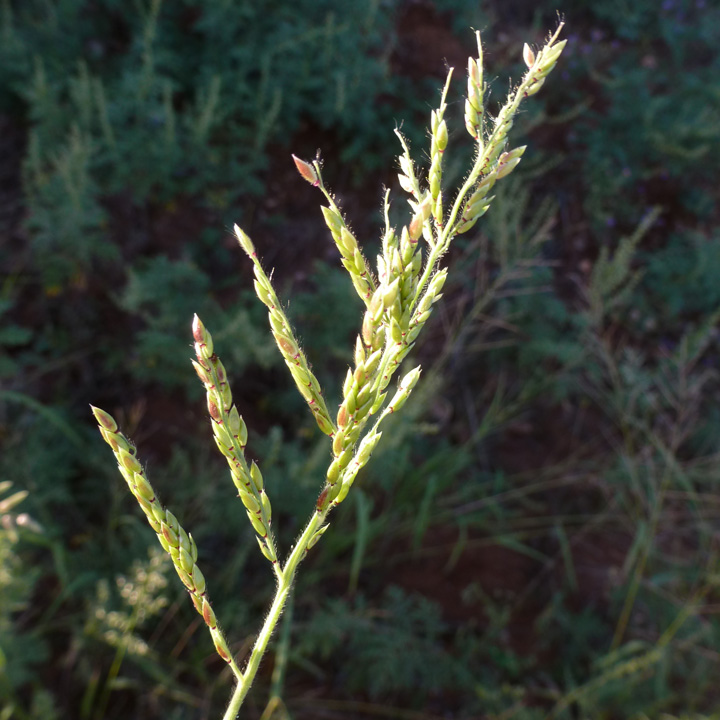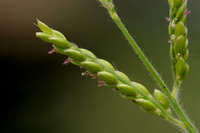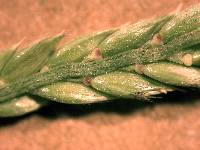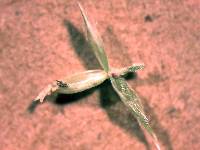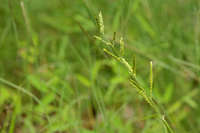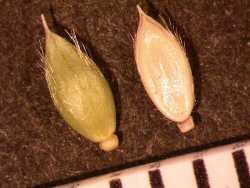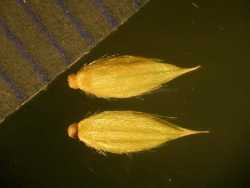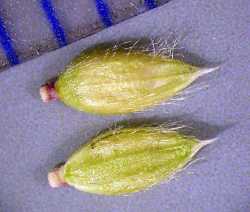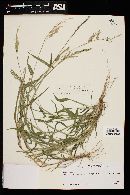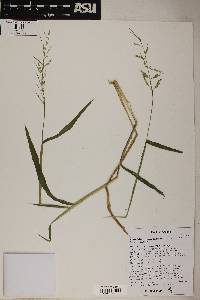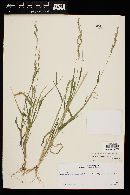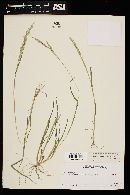- Home
- Search
- Images
- Datasets
- Sample Use
- How to Cite
- Additional Information
- About NEON
- NEON Data Portal
- ASU Biocollections
- About Symbiota
|
|
|
|
Family: Poaceae
tapertip cupgrass, more...tapertip cupgrass
[Eriochloa acuminata var. minor (Vasey) R.B.Shaw, moreEriochloa gracilis (E.Fourn.) Hitchc., Eriochloa gracilis var. minor (Vasey) Hitchc., Eriochloa lemmonii var. gracilis (E.Fourn.) Gould, Eriochloa punctata var. minor Vasey] |
Plants annual; cespitose. Culms 30-120 cm, erect or decumbent, sometimes rooting at the lower nodes; internodes glabrous or with scattered hairs; nodes glabrous or pilose. Sheaths sometimes conspicuously inflated, glabrous or pubescent; ligules 0.2-1.2 mm; blades 5-12(18) cm long, (2)5-12(16) mm wide, linear, flat or folded, straight or lax, glabrous or sparsely pubescent adaxially. Panicles 7-16 cm long, 1-6 cm wide, loosely contracted; rachises scabrous or hairy; branches 5-20, 1-5 cm long, 0.4-0.6 mm wide, appressed to divergent, pubescent, sometimes setose, not winged, with 20-36 spikelets, spikelets mostly in unequally pedicellate pairs, solitary distally; pedicels 0.1-1 mm, hairy. Spikelets 3.8-5(6) mm long, 1.1-1.4 mm wide, lanceolate to ovate. Lower glumes absent; upper glumes equaling the lower lemmas, lanceolate to ovate, hairy, 5(7)-veined, acuminate to acute, unawned or awned, awns to 1.2 mm; lower lemmas 3.6-5 mm long, 1.1-1.4 mm wide, lanceolate to ovate, setose, 5(7)-veined, acuminate to acute, unawned; lower paleas absent; anthers absent; upper lemmas 2.3-3.3 mm, 0.7-0.9 times as long as the lower lemmas, indurate, elliptic, rounded, 5-veined, awned, the awns 0.1-0.3 mm; upper paleas indurate, blunt, rugose. 2n = 36. Eriochloa acuminata is native to the southern United States and northern Mexico, but has become established outside this region. It may hybridize with E. lemmonii, from which it differs in its lack of lower paleas, upper glumes and lower lemmas with level veins, and narrower, glabrous or sparsely pubescent leaf blades. There are two varieties of Eriochloa acuminata, differing as shown in the key below. FNA 2003, Gould 1980 Common Name: tapertip cupgrass Duration: Annual Nativity: Native Lifeform: Graminoid General: Annual grass, stems 20-100 cm, long, weak, and usually decumbent or geniculate below, sometimes rooting at lower nodes; herbage can be glabrous to hirsute. Vegetative: Blades bright green, glabrous or rarely thinly pubescent, thin, 3-10 mm broad; ligule of soft hairs; sheaths glabrous or occasionally hirsute. Inflorescence: Panicle 6-18 cm long, with 5-20 appressed or erect-spreading branches; the branches 1-5 cm long, widely spaced along the main axis, dense with 20-36 appressed spikelets, mostly in unequally pedicellate pairs; inflorescence branches and pedicels flattened or angular, densely pubescent with hairs to 4 mm long; spikelets 4-5 mm long, with 2 florets, lower florets usually sterile, upper florets bisexual; first glume absent; second glume and sterile lemma abruptly acuminate, mostly 3-4 mm long, appressed-pubescent; fertile lemma oblong, finely reticulate, abruptly cuspidate at the apex. Ecology: Found in sandy washes and depressions, along streams, and on disturbed soils from 2,500-5,500 ft (762-1676 m); flowers August-October. Distribution: Much of the southern half of the US; from CA east to MD; south to s MEX. Notes: Eriochloas are grasses with hard, single-seeded, pointy-tipped spikelets resembling panicum; this species is an annual with hairy infertile lemmas and glumes; no awns; and small reddish cupules at the base of each spikelet which are left behind after spikelets fall. FNA recognizes 2 varieties: E. acuminata var. minor has spikelets with acute tips, while E. acuminata var. acuminata has spikelets with long-acuminate tips which can terminate in a short awn. Ethnobotany: Unknown Etymology: Eriochloa from Greek erion, wool, and chloe or chloa, grass, while acuminata means having a long tapering point. Synonyms: None Editor: SBuckley 2010, FSCoburn 2014, AHazelton 2015 |
|
|
|


